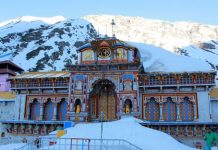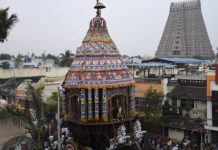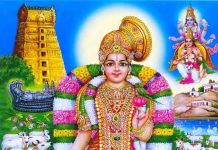EkAdasi Vratham observance is very important to the bhakthAs of Sriman NaarAyaNA. For the EkAdasi Vratham, one observes oru vELai (eating once) during Dasami Tithi and fasts thru EkAdasi day fully and conclude it with partaking of special kind of food on DvAdasi day while the Tithi is there. For more, please visit Part 1 introduction in the following link: The Twenty Five Ekadasis And Its Signifiance – Part 1- Introduction
Moksha EkAdasi or Vaikunta EkAdasi (Marghazhi Sukla Paksha EkAdasi): This is a very special EkAdasi linked to Moksham and Lord RanganAthan enters Vaikunta Vaasal to enact the role of a Jeevan that desires to gain Moksham. Any one, who follows Him through that northern gate at Srirangam (Parama Padha Vaasal) is sure to attain Moksham.
The ritualistic celebration of Sri Vaikunta EkAdasi at the sacred Srirangam temple commences on the first day of Iraa patthu and ends with NammAzhwAr’s moksahm on the tenth day of this festival. This uthsavam fits with the ritualistic aspects going back to the time of Thirumangai AzhwAr, when he started the AdhyayaNOthsvam at Srirangam as a result of the niyamanam of NamperumAL.
PurANic episodes deal with the significance of this special celebration (Amrutha mathanam, GeethOpadesa dinam, Lokan-KaNtakan Moksha dinam). Also AzhwAr and Achaarya Sooktis on ArchirAdhi Maargam (Brahma Soothram, NammAzhwAr, Acharya RaamAnujA, Swami Desikan’s Sri Sookthis) relate to Sri Vaikuntam and Moksha siddhi.
The famous slOkam about EkAdasi Vratham is:
na GaayathryA para manthra: na Maathu para dhaivatham
na KaasyA: paramam theertham na EkAdasyA : samam vratham
Meaning:
There is no manthram that is superior to Gaayathri manthram; there is no dhaivam superior to one’s mother; there is no sanctifying theertham better than Kaasi and there is no vratham that is more sacred than EkAdasi Vratham. King RukmAngathA, NampAduvAN Kaisikan, our AchAryAs of all Vaidhika mathams have demonstrated the greatness and power of observing EkAdasi Vratham. Through his observance of EkAdasi vratham, a Harijan like NampAduvAn has reached such an exalted status to get an EkAdasi and a chapter of Varaha PurAnam named after him (Kaisika EkAdasi and kaisika MahAthmyam). Sri Parasara Bhattar wrote a commentary on the Kaisika PurANam in Tamil. Parasara Bhattar read this work in front of Sri RanganathA on a Vrisichika Maasa (Nov-Dec) sukla paksah EkAdasi and was recognized by Sri RanganAthA with a Brahma ratham (Being carried around the streets of Srirangam on a palanquin by BrahmaNAs).
Of all EkAdasis, the one connected with Dhanur Maasa Sukla Paksha EkAdasi is the most exalted and is known as Sri Vaikunta EkAdasi. There are number of reasons associated with the special significance of this EkAdasi:
(1) This is the day of the churning of the Milky Ocean for nectar. Besides Amrutham, KaamadhEnu, Ucchaisravas, Iraavatham, Kalpa Vruksham, Apsaras, Kousthubham, and PaarijAtha Pushpam appeared as a result of the churning.
(2) The most exalted of auspiciousness that happened on this day is the appearance of MahA Lakshmi. She appeared with the golden colour (HiraNya VarNAm HariNIm SuvarN arajathasrajAm) and shining with Her innate glory like a cool moon (ChandhrAm prabhAsAm YasasA jvalanthIm). Like a brilliant lightning bolt out of the sky, she incarnated right in front of the Lord engaged in churning the Ocean and made all the directions shine with Her glory (Ranjayanthi disa: kAnthyA Vidhyuth SoudhAmini YathA).
(3) BhagavAn Dhanvanthri appeared thereafter with the amrutha Kalasam (AmruthApUrNa Kalasam Bibhrath Valaya BhUshitha: ).
(4) According to one school, the day of the GitA Upadesam to Arjuna by the Lord on the battle field is said to be on Sri Vaikunta EkAdasi day. Some opine that it was on Vijaya dasami day that Our Lord commented on the significance of GitA in VarAha PurANam this way:
GitA jn~Anam upAsrithya ThrIn lOkAn PaalayAmyaham GitA mE paramA vidhyA Brahma RoopA na Samsaya:
Meaning:
I am rooted in GitA. The passages of GitA are sections of my temple. Thru the Jn~Ana Saaram housed in GitA, I rule the three worlds. GitA is my supreme Vidhyai (UpadEsam/revealed knowledge to reach me). It points out to the way for Moksham. It can not be separated from Me. It is beyond the limits of Desam, Kaalam and other limitations. This is the essence of VedAs and Upanishads. It is the key to open the lock of Athma VichAram and to gain Moksha Siddhi. That is why the day of birth of this sacred revelation, Sri Vaikunta Ekadasi day is considered the most sacred.
Lord Parthasarathy says further:
yOashtadasajapO nithyam narO niscchala maanasa: Jn~Ana siddhim sa labathE tathO yAthi param padham
Meaning:
The One who reads all the 18 chapters of my GithOpanishad and meditates as well as comprehends the meanings of the verses, will come sthitha Praj~nan, achieve Jn~Ana sampath and finally reach the safety and comfort of the shadow of my feet and gets fulfilled in his life’s purpose.
The tattvam behind Sri Vaikunta EkAdasi or MokshEkAdasi is the principles taught by Sri ParthasArathy to us through ArjunA as an excuse (vyAjyam).
They are the essence of VedAs, Upnishads, AnushtAnAs, ashtAnga Yogam et al. Those who are not able to comprehend the esoteric doctrines of the Vedas, Upanishads or able to practise anushtAnams and Yogams can wake up in Brahma muhUrtham on the month declared as the most holy by GitAchAryan (MaasAnAm margasIrsham), recite ThirupaLLIyezucchi, ThiruppAvai, participate in the Thiru Adhyayana Uthsavam and on Sri Vaikunta EkAdasi day travel with the Lord thru parama padha Vaasal and get Moksha Siddhi. The Lord Himself enacts the role of a Mumukshu ,the Jeevan earning for Moksham on this day.
Lokan-Kantakan and Sri Vaikunta Ekaadasi
Thiru Adhyayana uthsavam starts on Dhanur maasam Sukhla Paksha Prathamai and continues for 21 days that are divided into Pahal and Iraa Patthu. Sri PaancharAthra Aagamam explains the reason for the initiation of this Uthsavam. During the great deluge (PraLayam), Lord was floating on the swirling waters of deluge on the leaf of a pupil tree as a small baby (Vata Pathra Saayee). He created chathurmukha BrahmA and commanded him to engage in the act of Creation.
Soon, BrahmA forgot as to who had created him in the first place and was stricken with ego as he went about his act of creation. At that time, two asurAs with the names of Lokan and Kantakan emerged out of the ears of the Lord and jumped on Brhama with an intent to kill him for his offences. BrahmA quickly understood the fix that he got himself into and prayed to his father, the Lord to save him. The Lord forgave BrahmA. The Lord also wanted to give a boon for the two asurAs for the services rendered and asked them as to what they would like to have as boons. They begged the Lord to give them the boon of battling with Him for a month and then reach His sacred feet. The Lord blessed them with the boon and fought with them for a month and at the end killed them; thereafter, our Lord transformed them into Nithya sUris with sankham and chakram and made them residents of Sri Vaikuntam.
At that time, Lokan and Kantan addressed the Lord and said: “Oh Sriman NaarAyaNA! We have had the blessings of sathgathi thanks to your killing us with Your own hands and made it possible for us to reside in Sri Vaikuntam and to perform nithya kaimkaryam to You. You let us in to Sri Vaikuntam by opening the northern gates of Your divine citadel on this Dhanur maasa sukla Paksha EkAdasi day. We beg you to give us another boon, which will make it possible for all the people to remember us and this day as Sri Vaikunta EkAdasi. Please grant us this boon, which will make it possible for ALL human beings, who enter the Northern gates at all of Your consecrated temples on Earth to reach Sri Vaikuntam, when their body falls down on this earth at the end of their sojourn on Your earth. After reaching Your Kingdom of Sri Vaikuntam, they should also be blessed with Nithya sEvA Kaimkaryam like us and all other Nithya sUris:
tathA pasyanthi yEthvAnthu namasyanthi cha yE janA : uttara dwAra maargENa pravisanthi cha yE HarE :
tE Vaikuntamimam prApya mOdhanthAm nityasUrivath
BhagavAn Sriman NaarAyaNA offered them that boon as well. From that day onward, Lord accepted Sri Vaikunta EkAdasi Uthsavam and the entrance of BhakthAs through the northern gate of His temples to reach Srivaikuntam at the end of their earthly residence.Since this EkAdasi is connected with Moksham, this uthsavam came to be known as MokshOthsavam from then on.
AzhwArs and Thiru AdyayanOthsvam (Moksha EkAdasi)
In Tamil Nadu, AzhwArs used Divya Prabhandham (Tamil Vedam/MaRai) to worship Sriman NaarAyaNA and attained Moksha Siddhi. The First AzhwAr in our tradition that served as Maarga darsi or the shower of the way was “Vedam Tamizh seytha MaaRan”, Swami Sri NammAzhwAr. In the last centum of his Thiruvaimozhi, he takes leave of many archA mUrthys with a heavy heart and describes his joyous plans to leave this earth at the end of his avathAra mission to reach the abode of his Lord, Sri Vaikuntam. Like Andal, who described in great detail Her impending marriage to Her Lord through a dream scene (VaraNamyiram Paasurams), NammAzhwAr similarly used Veda PramANams to describe his journey to Parama padham as revealed to us in Brahma sUthrams and Upanishads.
Few hundred years later, the last of the AzhwArs, Thirumangai, was standing in front of Sri RanganaathA at Srirangam enjoying His divine beauty and was reflecting on the tenth ThirumAlai Paasuram of ThondaradipoDi: “KaatinAn Thiruvarangam Uyvbavarkku uyyum vaNNam” AzhwAr wondered about his own moksham. He broke out in a thought sequence, which took the form of the following paasuram passage:
“aNiyAr pozhil Aranga naharappA ! tuNiyEn
ini ninnaraulallAthu, naNiyE, MaNi MaaNikkamE, MadhusoodhA ! paNiyAi yenakku uyyum vahai ParamjyOthi”
Our most merciful Lord of Srirangam responded through Uttama nambi, His priest and showed the way for his salvation.
AzhwAr was thrilled with that revelation and organized the ThirukkArthigai Uthsavam to celebrate the immeasurable, tall Jyothi (anthar jyOthi: kimapi yaminAm anjanam Yoga dhrushtE, as revealed later by Swami Sri Desikan) as Sriman NaarayaNa Tattvam reclining on the bed of Adhi sEshan at Srirangam. Thirumangai understood now that was the same “tall” jyOthi tattvam revealed by Sri RanganaathA to NammAzhwAr earlier. Recognizing this as divine indication, Thirumangai brought Swami Sri NammAzhwAr’s archA vigraham from AzhwAr Thirunagari with pomp and maryAdhai to Srirangam and placed nammAzhwAr’s vigraham in front of Sri RanganAthan. He begged the Lord and requested Him to instruct the world about the Veda Saamyam of Thiruvaimozhi through the conductance of an uthsavam to highlight the extraordinary relevance and greatness of ThiruvAimozhi as Tamil MaRai. Our Lord of Srirangam agreed and gave the orders for the initiation of Adhyayana Uthsavam, which is also known today as MokshOthsavam as a result of Thirumangai Mannan’s imitative and the continuation of that Kaimkaryam by our PurvAchAryas from AchArya Naatha Muni’s time.
English Commentary by Sri Oppiliappan Sadagopan
The following is the significance of Mokshada Ekadasi in Tamil:






